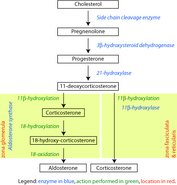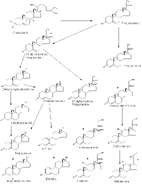(Update wp) |
|||
| (4 intermediate revisions by one other user not shown) | |||
| Line 1: | Line 1: | ||
{{bioPsy}} |
{{bioPsy}} |
||
| − | {{Chembox new |
||
| − | | ImageFile = Aldosterone.svg |
||
| − | | ImageSize = |
||
| − | | IUPACName = |
||
| − | | OtherNames = |
||
| − | | Section1 = {{Chembox Identifiers |
||
| − | | CASNo = 52-39-1 |
||
| − | | PubChem = |
||
| − | | SMILES = OCC(=O)[C@H]4CC[C@@H]2[C@@]4<br>(C[C@H](O)[C@@H]1C3[C@H](C)CC<br>(=O)/C=C3/CC[C@H]12)C=O |
||
| − | | MeSHName = Aldosterone |
||
| − | }} |
||
| − | | Section2 = {{Chembox Properties |
||
| − | | Formula = C<sub>21</sub>H<sub>28</sub>O<sub>5</sub> |
||
| − | | MolarMass = |
||
| − | | Appearance = |
||
| − | | Density = |
||
| − | | MeltingPt = |
||
| − | | BoilingPt = |
||
| − | }} |
||
| − | | Section3 = {{Chembox Hazards |
||
| − | | Solubility = |
||
| − | | MainHazards = |
||
| − | | FlashPt = |
||
| − | | Autoignition = |
||
| − | }} |
||
| − | }} |
||
'''Aldosterone''' is a [[steroid hormone]] ([[mineralocorticoid]] family) produced by the outer-section ([[zona glomerulosa]]) of the [[adrenal cortex]] in the [[adrenal gland]] to regulate [[sodium]] and [[potassium]] balance in the [[blood]]. |
'''Aldosterone''' is a [[steroid hormone]] ([[mineralocorticoid]] family) produced by the outer-section ([[zona glomerulosa]]) of the [[adrenal cortex]] in the [[adrenal gland]] to regulate [[sodium]] and [[potassium]] balance in the [[blood]]. |
||
| Line 38: | Line 12: | ||
==Function== |
==Function== |
||
| − | Aldosterone is the primary of several endogenous members of the class of [[mineralocorticoid]]s in human. [[Deoxycorticosterone]] is another important member of this class. |
+ | Aldosterone is the primary of several endogenous members of the class of [[mineralocorticoid]]s in human. [[Deoxycorticosterone]] is another important member of this class. Aldosterone has two main actions: |
# Acting on [[mineralocorticoid receptor]]s (MR) on principal cells in the distal tubule of the kidney nephron, it increases the permeability of their [[apical]] (luminal) membrane to potassium and sodium and activates their [[basolateral]] [[Na+/K+-ATPase|Na<sup>+</sup>/K<sup>+</sup> pumps]], stimulating [[Adenosine triphosphate|ATP]] hydrolysis, reabsorbing sodium (Na<sup>+</sup>) ions and water into the blood, and secreting potassium (K<sup>+</sup>) ions into the urine. (Chlorine anions are also reabsorbed in conjunction with sodium cations to maintain the system's electrochemical balance.) |
# Acting on [[mineralocorticoid receptor]]s (MR) on principal cells in the distal tubule of the kidney nephron, it increases the permeability of their [[apical]] (luminal) membrane to potassium and sodium and activates their [[basolateral]] [[Na+/K+-ATPase|Na<sup>+</sup>/K<sup>+</sup> pumps]], stimulating [[Adenosine triphosphate|ATP]] hydrolysis, reabsorbing sodium (Na<sup>+</sup>) ions and water into the blood, and secreting potassium (K<sup>+</sup>) ions into the urine. (Chlorine anions are also reabsorbed in conjunction with sodium cations to maintain the system's electrochemical balance.) |
||
# Aldosterone stimulates H<sup>+</sup> secretion by [[intercalated cells]] in the collecting duct, regulating plasma [[bicarbonate]] (HCO<sub>3</sub><sup>−</sup>) levels and its acid/base balance.<ref>Brenner & Rector's The Kidney, 7th ed. Saunders, 2004.</ref> |
# Aldosterone stimulates H<sup>+</sup> secretion by [[intercalated cells]] in the collecting duct, regulating plasma [[bicarbonate]] (HCO<sub>3</sub><sup>−</sup>) levels and its acid/base balance.<ref>Brenner & Rector's The Kidney, 7th ed. Saunders, 2004.</ref> |
||
| − | # Aldosterone acts on the [[central nervous system]] to increase a person's appetite for salt, and to make them feel thirsty. |
+ | # Aldosterone acts on the [[central nervous system]] to increase a person's appetite for salt, and to make them feel [[thirst|thirsty]]. |
| − | Aldosterone is responsible for the reabsorption of about 2% of filtered sodium in the kidneys, which is nearly equal to the entire sodium content in human blood under normal GFR ( |
+ | Aldosterone is responsible for the reabsorption of about 2% of filtered sodium in the kidneys, which is nearly equal to the entire sodium content in human blood under normal GFR (glomerular filtration rate).<ref>Sherwood, L. Human Physiology, from Cells to Systems, 4th Ed., Brooks/Cole, 2001</ref> |
==Location of receptors== |
==Location of receptors== |
||
Unlike [[neuroreceptor]]s, classic [[steroid]] receptors are intracellularly located. The aldosterone/MR receptor complex binds on the DNA to specific [[hormone response element]], which leads to gene specific [[transcription (genetics)|transcription]]. |
Unlike [[neuroreceptor]]s, classic [[steroid]] receptors are intracellularly located. The aldosterone/MR receptor complex binds on the DNA to specific [[hormone response element]], which leads to gene specific [[transcription (genetics)|transcription]]. |
||
| − | Some of the transcribed genes are crucial for [[transepithelial sodium transport]], including the three |
+ | Some of the transcribed genes are crucial for [[transepithelial sodium transport]], including the three subunits of the [[epithelial sodium channel]], the [[Na+/K+-ATPase|Na<sup>+</sup>/K<sup>+</sup> pumps]] and their regulatory proteins [[serum and glucocorticoid-induced kinase]], and [[channel-inducing factor]] respectively. |
==Stimulation of synthesis== |
==Stimulation of synthesis== |
||
| Line 60: | Line 34: | ||
* by the [[stretch receptors]] located in the [[atria]] of the heart. If decreased blood pressure is detected, the adrenal gland is stimulated by these stretch receptors to release aldosterone, which increases sodium reabsorption from the urine, sweat and the gut. This causes increased osmolarity in the extracellular fluid which will eventually return blood pressure toward normal. |
* by the [[stretch receptors]] located in the [[atria]] of the heart. If decreased blood pressure is detected, the adrenal gland is stimulated by these stretch receptors to release aldosterone, which increases sodium reabsorption from the urine, sweat and the gut. This causes increased osmolarity in the extracellular fluid which will eventually return blood pressure toward normal. |
||
| − | The secretion of aldosterone has a [[ |
+ | The secretion of aldosterone has a [[diurnal rhythm]].<ref>Hurwitz S, Cohen R, & Williams GH. ''Diurnal variation of aldosterone and plasma renin activity: timing relation to melatonin and cortisol and consistency after prolonged bed rest.'' |
2004 J Appl Physiol 96: 1406-1414. [http://jap.physiology.org/cgi/content/full/96/4/1406 Full Text]</ref> |
2004 J Appl Physiol 96: 1406-1414. [http://jap.physiology.org/cgi/content/full/96/4/1406 Full Text]</ref> |
||
| Line 76: | Line 50: | ||
Image:Corticosterone.svg|[[Corticosterone]] |
Image:Corticosterone.svg|[[Corticosterone]] |
||
</gallery> |
</gallery> |
||
| + | |||
| + | |||
| + | ==See also== |
||
| + | *[[Adrenal cortex hormones]] |
||
| ⚫ | |||
| + | *[[ACTH stimulation test]] |
||
==References== |
==References== |
||
| Line 87: | Line 67: | ||
{{Hormones}} |
{{Hormones}} |
||
| ⚫ | |||
| + | |||
| + | [[Category:Adrenal cortex hormones]] |
||
| + | [[Category:Corticosteroids]] |
||
[[Category:Mineralocorticoids]] |
[[Category:Mineralocorticoids]] |
||
[[Category:Steroid hormones]] |
[[Category:Steroid hormones]] |
||
| + | [[Category:Thirst]] |
||
<!-- |
<!-- |
||
Latest revision as of 01:11, 28 April 2008
Assessment |
Biopsychology |
Comparative |
Cognitive |
Developmental |
Language |
Individual differences |
Personality |
Philosophy |
Social |
Methods |
Statistics |
Clinical |
Educational |
Industrial |
Professional items |
World psychology |
Biological: Behavioural genetics · Evolutionary psychology · Neuroanatomy · Neurochemistry · Neuroendocrinology · Neuroscience · Psychoneuroimmunology · Physiological Psychology · Psychopharmacology (Index, Outline)
Aldosterone is a steroid hormone (mineralocorticoid family) produced by the outer-section (zona glomerulosa) of the adrenal cortex in the adrenal gland to regulate sodium and potassium balance in the blood.
It was first isolated by Simpson and Tait in 1953.[1]
Synthesis
The corticosteroids are synthesized from cholesterol within the adrenal cortex. Most steroidogenic reactions are catalysed by enzymes of the cytochrome P450 family. They are located within the mitochondria and require adrenodoxin as a cofactor (except 21-hydroxylase and 17α-hydroxylase).
Aldosterone and corticosterone share the first part of their biosynthetic pathway. The last part is either mediated by the aldosterone synthase (for aldosterone) or by the 11β-hydroxylase (for corticosterone). These enzymes are nearly identical (they share 11β-hydroxylation and 18-hydroxylation functions). But aldosterone synthase is also able to perform a 18-oxidation. Moreover, aldosterone synthase is found within the zona glomerulosa at the outer edge of the adrenal cortex; 11β-hydroxylase is found in the zona fasciculata and reticularis.
Note: aldosterone synthase is absent in other sections of the adrenal gland.
Function
Aldosterone is the primary of several endogenous members of the class of mineralocorticoids in human. Deoxycorticosterone is another important member of this class. Aldosterone has two main actions:
- Acting on mineralocorticoid receptors (MR) on principal cells in the distal tubule of the kidney nephron, it increases the permeability of their apical (luminal) membrane to potassium and sodium and activates their basolateral Na+/K+ pumps, stimulating ATP hydrolysis, reabsorbing sodium (Na+) ions and water into the blood, and secreting potassium (K+) ions into the urine. (Chlorine anions are also reabsorbed in conjunction with sodium cations to maintain the system's electrochemical balance.)
- Aldosterone stimulates H+ secretion by intercalated cells in the collecting duct, regulating plasma bicarbonate (HCO3−) levels and its acid/base balance.[2]
- Aldosterone acts on the central nervous system to increase a person's appetite for salt, and to make them feel thirsty.
Aldosterone is responsible for the reabsorption of about 2% of filtered sodium in the kidneys, which is nearly equal to the entire sodium content in human blood under normal GFR (glomerular filtration rate).[3]
Location of receptors
Unlike neuroreceptors, classic steroid receptors are intracellularly located. The aldosterone/MR receptor complex binds on the DNA to specific hormone response element, which leads to gene specific transcription.
Some of the transcribed genes are crucial for transepithelial sodium transport, including the three subunits of the epithelial sodium channel, the Na+/K+ pumps and their regulatory proteins serum and glucocorticoid-induced kinase, and channel-inducing factor respectively.
Stimulation of synthesis
Aldosterone synthesis is stimulated by several factors:
- by increased plasma angiotensin II, ACTH, or potassium levels, which are present in proportion to plasma sodium deficiencies. (The increased potassium level works to regulate aldosterone synthesis by depolarizing the cells in the zona glomerulosa, which opens the voltage-dependent calcium channels.) The level of angiotensin II is regulated by angiotensin I, which is in turn regulated by the hormone renin.
- by plasma acidosis.
- by the stretch receptors located in the atria of the heart. If decreased blood pressure is detected, the adrenal gland is stimulated by these stretch receptors to release aldosterone, which increases sodium reabsorption from the urine, sweat and the gut. This causes increased osmolarity in the extracellular fluid which will eventually return blood pressure toward normal.
The secretion of aldosterone has a diurnal rhythm.[4]
Control of aldosterone release in the kidney
- The role of the renin-angiotensin system
- The role of sympathetic nerves
- The role of baroreceptors
- The role of the juxtaglomerular apparatus
- The plasma concentration of potassium
Additional images
See also
References
- ↑ Williams JS, Williams GH. 50th anniversary of aldosterone. J Clin Endocrinol Metab. 2003 Jun;88(6):2364-72. Full text. PMID 12788829.
- ↑ Brenner & Rector's The Kidney, 7th ed. Saunders, 2004.
- ↑ Sherwood, L. Human Physiology, from Cells to Systems, 4th Ed., Brooks/Cole, 2001
- ↑ Hurwitz S, Cohen R, & Williams GH. Diurnal variation of aldosterone and plasma renin activity: timing relation to melatonin and cortisol and consistency after prolonged bed rest. 2004 J Appl Physiol 96: 1406-1414. Full Text
External links
|}
Target-derived NGF, BDNF, NT-3
|}
| This page uses Creative Commons Licensed content from Wikipedia (view authors). |


